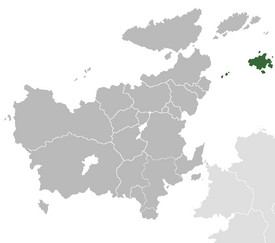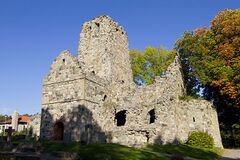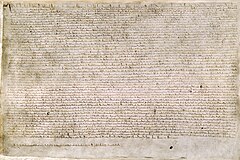Geatland: Difference between revisions
| Line 159: | Line 159: | ||
In Geatish history, the [[Greater Realm period]] typically begins with [[Unification of Geatland|Geatish Unification]] in 1545 and ends with constitutional reforms in 1867, though it may be extended to the onset of the [[Great War (Kylaris)|Great War]]. The Greater Realm period saw the rise and fall of Geatish colonalism in [[Northern Asteria]], the height of Geatish naval authority, and the period of conservative {{wp|absolute monarch|absolutism}}. | In Geatish history, the [[Greater Realm period]] typically begins with [[Unification of Geatland|Geatish Unification]] in 1545 and ends with constitutional reforms in 1867, though it may be extended to the onset of the [[Great War (Kylaris)|Great War]]. The Greater Realm period saw the rise and fall of Geatish colonalism in [[Northern Asteria]], the height of Geatish naval authority, and the period of conservative {{wp|absolute monarch|absolutism}}. | ||
The [[Blåstad|Principality of Blåstad]], which was historically a backwater in the Geatish hinterland, grew in | The [[Blåstad|Principality of Blåstad]], which was historically a backwater in the Geatish hinterland, grew in prominence. The {{wp|principality}}'s connection as a {{wp|port city}} to [[Euclea|Continental Euclea]] afforded it wealth and stability. The rulers of Blåstad, then, were among the most powerful on the [[Geatish Islands]], often marrying [[Gaullica|Gaullican]], [[Kingdom of Estmere|Estmerish]] or other Continental Euclean princesses. In 1534, [[Eric the Great|Erik Longbeard]] was made Prince of Blåstad. The [[Brutish Wars]] were slowing to an end, and Erik's Blåstad became the {{wp|hegemony|hegemon}}. Erik was therefore uniquely poised to unite Geatland oncemore, and his control of trade on the Islands brigaded the lesser principalities into joining him. Erik's mostly-bloodless efforts culminated in [[Unification of Geatland|Geatish Unification]] in 1545, with Erik being crowned as Eric IV, later to be known as [[Eric the Great]], {{wp|absolute monarchy|absolute monarch}} of the "Second Kingdom of Geatland", which he would later rename to the [[Geatland|Geatish Realm]]. | ||
[[File:Thomas Baines - The British Settlers of 1820 Landing in Algoa Bay - 1853.png|right|thumb|240px|Geatish explorer and pirate [[Hans | [[File:Thomas Baines - The British Settlers of 1820 Landing in Algoa Bay - 1853.png|right|thumb|240px|Geatish explorer and pirate [[Hans Hammar Adelström]] lands on the Horn of Asteria in 1547, claiming the territory for the Geatish crown. ]] | ||
During Eric's reign, many Euclean powers began efforts to colonize parts of the Asterias, particularly [[Asteria Superior]]. Eric had conscripted [[Hans | During Eric's reign, many Euclean powers began efforts to colonize parts of the Asterias, particularly [[Asteria Superior]]. Eric had conscripted [[Hans Hammar Adelström]], an {{wp|exploration|explorer}} and {{wp|pirate}}, to gather the resources for a potential voyage as early as 1543. By the time Geatland was unified, Adelström had gathered the resources to set off on his voyage in October 1546. By 1457, Adelström landed on the Horn of Asteria and established a {{wp|human settlement|settlement}}. Adelström attempted to bridge relations with the Yamuya and Odavli peoples, but his efforts failed and forced to resort to violence. Adelström's actions resulted in the {{wp|genocide of indigenous peoples|genocide of the indigenous Asterian peoples}}. By 1550, Eric the Great formally created Adelström as the Viceroy of [[Eldmark]], taking the title of {{wp|King}} of Eldmark for his own. | ||
Geatland would grow rich off of the {{wp|tobacco}} and {{wp|gold}} it was able to produce in its Eldmarsk colony. Eldmark's | Geatland would grow rich off of the {{wp|tobacco}} and {{wp|gold}} it was able to produce in its Eldmarsk colony. Eldmark's strategic position proved tenuous for Geatland, as other Euclean powers like [[Gaullica]] and [[Estmere]] often menaced Geatish claims. By 1562, [[Caldia]] ceded [[Imagua and the Assimas]] to the Realm, expanding Geatland's colonial portfolio. | ||
===Contemporary history=== | ===Contemporary history=== | ||
Revision as of 12:47, 11 July 2020
Geatish Realm Götiska riket | |
|---|---|
| Motto: "För Gud och Kronan" (Geatish) "For God and the Crown" | |
| Anthem: "Hör, o Nordmän!" (Hear, O Norsemen!) | |
 Location of Geatland (in green), within Euclea (grey) | |
| Capital and largest city | Blåstad |
| Official languages | Geatish |
| Recognised regional languages | Azmaran |
| Religion | Church of Geatland |
| Demonym(s) | Geats |
| Government | Unitary parliamentary constitutional monarchy |
• Monarch | Brunhild II |
• Premier | Karl Nilsson Jung |
| FOLK-Fråmat! | |
| Legislature | Riksdag |
| Landsting | |
| Folkting | |
| Unification | |
| 944 | |
| 1057 | |
| 5 August 1545 | |
• Annexation of the Line Islands | 26 March 1855 |
• Current Constitution | 13 July 1867 |
| Area | |
• Total | 90,819 km2 (35,065 sq mi) |
| Population | |
• 2019 estimate | |
• 2017 census | |
• Density | 67.1/km2 (173.8/sq mi) |
| GDP (PPP) | 2018 estimate |
• Total | $307.1 billion |
• Per capita | $49,588 |
| GDP (nominal) | estimate |
• Total | $262.675 billion |
• Per capita | $42,421 |
| Gini (2017) | 40.1 medium |
| HDI (2017) | 0.911 very high |
| Currency | Geatish krona |
| Date format | dd/mm/yyyy (AD) |
| Driving side | left |
Geatland (Geatish: Gotland), officially the Geatish Realm, is a Euclean island country located in the North Sea. Geatland's territory comprises the Geatish Islands and the Line Islands. Its capital and largest city is Blåstad.
Geatland has an area of 90,819 square kilometres (35,065 sq mi) and a population of 6,192,106 people. Because Geatland is an island, its long shoreline affords it more mild temperatures than other countries on its latitude, though it may be much cooler in midland areas. The country is known for being mountainous.
Geatland is a unitary parliamentary constitutional monarchy. The current monarch and head of state is Brunhild II, who has been on the throne since 1966. The Geatish Islands are divided into counties and municipalities.
Weranic peoples came to settle the Geatish Islands in the 3rd century BC. The largest and most prominent of these Weranic tribes was the Ancient Geats, who subdued and conquered their neighbors. The First Kingdom of Geatland was established in 944. Geatland was involved in various North Sea Empires until the 14th century AD. After the collapse of the North Sea Empires, the Geatish Islands were politically fractured until their unification in 1545. Around this time, Geatland colonized Eldmark. Following King Rudolf's War, Geatland annexed the Line Islands from Azmara in 1855. The rise of republicanism and democracy in continental Euclea triggered the Engström Revolution. Though the revolution was unsuccesful in deposing the monarchy, it resulted in the writing of a constitution and democratic reforms that ended absolutism. Geatland sided with Functionalist Gaullica during the Great War. Geatish governments after the Great War inagurated an expansive welfare state, which persists in most forms today despite cuts in the 1970s to the 1990s.
Geatland is a prosperous liberal democracy and popular tourist destination. The country maintains a comprehensive social security system. It has among the highest rates of citizen happiness and clear air in the world. It is a member of the Community of Nations, ECDTO, the Northern Forum, the AEDC, and the ITO, among others.
Etymology and terminology
"Geatland" (Gotland in the Geatish language) is the standard short name for the Geatish Realm in Estmerish. The name refers to the lands of the Ancient Geats, one of the most prominent Sea Weranic tribes that migrated to the Geatish Islands as early as the third century before Jesus Sotiras. The standard adjective for things related to Geatland is Geatish, while people of Geatish origin are referred to as Geats. The denonym "Geats" traces its origin to Proto-Weranic *Gautoz, the exact etymology of which is unclear. The modern-day Geats draw their origins from the Ancient Geats as well as other tribal groups, such as the Gutes. However, since the Ancient Geats were the most powerful of the tribes and subdued the rest, their name survives in the country's name today.

Geatland has traditionally been referred to under different names. In Estmerish, it was common to refer to the country as Wedera or Wederia, from the Old Estmerish Wederas ("Geats"). Solarians referred to the Geatish Islands as Gothia, again after the Ancient Geat tribe. This name survives in Gaullican, in which Geatland is la Gothie.
The correct formal name for Geatland is the "Geatish Realm". The "Kingdom of Geatland" may be used in the place of the Geatish Realm, though this is typically seen as incorrect. This is because the Kingdom of Geatland historically only refers to the Geatish Islands and neglects Geatish sovereignty over the Line Islands. The Greater Geatish Realm may also refer to the extent of Geatish colonalism in North Asteria, particularly over Eldmark and Imagua and the Assimas.
History
Prehistory
The first human settlers on the Line Islands, Geatland's easternmost territories, are observed to have made landfall around the 7th millenium B.C. Most of these peoples were hunter-gatherers and fishermen from what is today Azmara.
Human settlement on the Geatish Islands was considerably later given the islands distance from mainland Euclea. The first attested evidence of habitation dates back to 1,500 B.C. The Geatish Islands were attested on some maps as early as 900 BC. Around the third or second century B.C., Sea Weranic tribes settled the islands. Some archaeologists dispute this date, however, and instead argue for habitation as late as the first century AD.
Solarian chroniclers and historians first make mention of the Geats around 110 AD. Solarian authors took note of the Geats' superiority over the other tribes, notably the Gutes, and their development of advanced naval technology, specifically longships. There are apocryphal accounts detailing the legendary kings of the Geats at this time. The most famous and best documented of these rulers was Alrik, a sea king and the legendary founder of the first major settlements on Gormö, the largest island in the Geatish Islands. Early Geatish socities were ruled by things, which were led by lawspeakers.
The inhabitants of the Geatish Islands were rather secluded and rarely traded with the outside world. If they did, they typically established small communities on the Euclean coast, around modern-day Azmara, Werania, and as far as Estmere to trade hides and ore with the Solarians.
The runic alphabet was developed in the second century AD. Runes would be formally phased out in the 11th century, but they remained in informal use as late as the 18th century.
Middle Ages

By the fall of the Solarian Empire in the 5th century AD, the Geats had succeeded in becoming the hegemon of the other tribes on the Geatish Islands. The beginning of the 8th century AD marked the beginning of the Age of Ghaillish Piracy. Ghaillish pirates from modern-day Caldia began conducting raids across Gormö, establishing a Gaillish raider kingdom on the island's north side by the 9th century. These pirates, who likewise raided the Euclean coast from Werania as far down to modern-day Estmere, routed the poorly equipped and technologically inferior Weranic tribes.

The beginning the First Kingdom of Geatland is somewhat unclear. There had been many kings before the 10th century, legendary or real, who had asserted control over all of the Geatish tribes, but in practice very few of these claims were borne out. To combat the Ghaillish, various Geatish chiefdoms united under kings.The strongest of these kingdoms were the rulers of Lågland ("The Low Lands"). In 941, Gorm the Elder, king of Lågland, succeeded in convincing holdout Geatish tribes to in the country's south to unite under him. Following a brief war to conquer the Gute tribes, Gorm declared himself the first King of all the Geats in 944. Before his death in 961, Gorm succeeded in diminishing the territory of the Ghaillish raider kingdom in Geatland's north, though it would remain a present force until the 12th century.
Gorm's successors extended the Kingdom's lands to the rest of the Geatish Islands by the end of the 11th century with little resistance. Geatland would not experience any more expansion in its territory until the sixteenth century and the colonization of Eldmark and Imagua and the Assimas.
Solarian Catholicism was introduced into the Geatish Islands in 839 by Saint Åke, the "apostle of Geatland." Sotirianism became the favored religion of the Geatish aristocracy and merchant class as it afforded them greater connections to continental Euclea. In 1057, king Olaf I was baptized a Sotirian on his ascension to the throne and Geatland became a Sotirian nation. Paganism, however, would continue to be popular among the lower class until the 14th century, when the entirely of the island was effectively Sotirianized.

Geatland's isolation from the rest of Euclea meant that it was poor and had a reputation within the continent as a backwards hinterland. Esholm, the kingdom's capital and a port city, was the only connection between Geatland and the rest of Euclea. Authority, though nominally vested in the monarch and his royal court, was decentralized into the hands of local barons. Thralldom, a system of slavery and serfdom, was widely popular from the 9th to the 11th century, but was slowly phased out thereafter. Thralldom would continue to become popular in iron mining towns until Eric the Great formally abolished the practice in 1553.
Around two hundred years after Gorm united the Geatish and Gutish tribes, the First Kingdom of Geatland began to fracture. It is unclear as to what should be considered the end date of the First Kingdom of Geatland. Various rulers maintained the title of "King of the Geats" or "King of Geatland" until the Great Unification in 1545. Although the First Kingdom of Geatland did not formally dissolve until 1425, most historians contend that its dissolution date to be 1287. King Valdemar II died without producing male heirs. The ensuing succession crisis pit Valdemar II's daughter Marta against her uncle Håkan the Bloody. This conflict led to the First Brutish War, a fifteen-year-old civil war that resulted in a stalemate. Håkan as nominally declared King of Geatland, but lost the support of the nobles beneath him and was ultimately a lame-duck king. Rival factions continued to war against each other in the ensuing Brutish Wars. Civil and political strife between claimants, barons, and lords plunged the Geatish Islands into constant civil war that would not end until 1545.
Greater Realm

In Geatish history, the Greater Realm period typically begins with Geatish Unification in 1545 and ends with constitutional reforms in 1867, though it may be extended to the onset of the Great War. The Greater Realm period saw the rise and fall of Geatish colonalism in Northern Asteria, the height of Geatish naval authority, and the period of conservative absolutism.
The Principality of Blåstad, which was historically a backwater in the Geatish hinterland, grew in prominence. The principality's connection as a port city to Continental Euclea afforded it wealth and stability. The rulers of Blåstad, then, were among the most powerful on the Geatish Islands, often marrying Gaullican, Estmerish or other Continental Euclean princesses. In 1534, Erik Longbeard was made Prince of Blåstad. The Brutish Wars were slowing to an end, and Erik's Blåstad became the hegemon. Erik was therefore uniquely poised to unite Geatland oncemore, and his control of trade on the Islands brigaded the lesser principalities into joining him. Erik's mostly-bloodless efforts culminated in Geatish Unification in 1545, with Erik being crowned as Eric IV, later to be known as Eric the Great, absolute monarch of the "Second Kingdom of Geatland", which he would later rename to the Geatish Realm.

During Eric's reign, many Euclean powers began efforts to colonize parts of the Asterias, particularly Asteria Superior. Eric had conscripted Hans Hammar Adelström, an explorer and pirate, to gather the resources for a potential voyage as early as 1543. By the time Geatland was unified, Adelström had gathered the resources to set off on his voyage in October 1546. By 1457, Adelström landed on the Horn of Asteria and established a settlement. Adelström attempted to bridge relations with the Yamuya and Odavli peoples, but his efforts failed and forced to resort to violence. Adelström's actions resulted in the genocide of the indigenous Asterian peoples. By 1550, Eric the Great formally created Adelström as the Viceroy of Eldmark, taking the title of King of Eldmark for his own.
Geatland would grow rich off of the tobacco and gold it was able to produce in its Eldmarsk colony. Eldmark's strategic position proved tenuous for Geatland, as other Euclean powers like Gaullica and Estmere often menaced Geatish claims. By 1562, Caldia ceded Imagua and the Assimas to the Realm, expanding Geatland's colonial portfolio.





